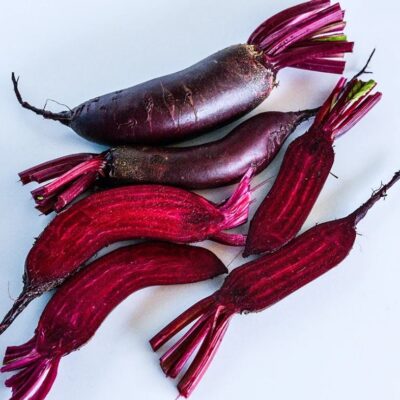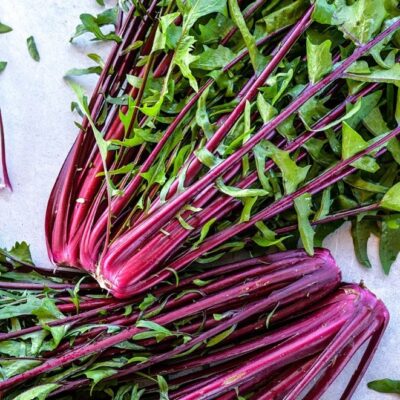Our garden plants have global origins. In this blog, we’ll consider those plants that had origins in Europe and Asia. The list includes both cool and warm season garden vegetables. The European and Asian varieties considered here include:
- Basil, Cardinal
- Beet, Cylindra
- Carrot, Pusa Asita Black
- Cucumber, Boston pickling
- Dandelion, Italiko Rossa
- Kale, Toscana
- Radish, Japanese Wasabi
Cool Season:
- Beet
- Carrot
- Dandelion
- Kale
- Radish
Warm Season:
- Basil
- Cucumber
Beets (Beta vulgaris). Beets are thought to have originated along the coast of the Mediterranean. By the end of the 15th century, cultivated beets were found throughout Europe.
The beet is derived from the wild beet (Beta maritima) which grows along the coast of Eurasia. There are three basic types of Beta vulgaris: chard, beets, and sugar beets. The beet is a root vegetable with purple-green leaves and a round or cylindrical taproot. The leaves taste is reminiscent of spinach. Both beet and spinach are in the same family (Chenopodiaceae or Goosefoot). To the ancient Greeks and Romans, the roots were black or white, but today they are more commonly red, white, or yellow.
The sugar beet was developed in the 1700s. A German scientist discovered that the long white root was a potential source of sugar. By the 1880s, sugar beets had been developed with 16-17% sugar content (originally, 6%). Factories in France, Belgium, Germany and Austria extracted sugar from these improved varieties. Sugar beets provide almost half of the worlds sugar today.
The beet was brought to America by European settlers. By 1800 the long, pointed root familiar in Europe developed into the round, bulbous vegetable we are familiar with today.
As home gardening became popular in the 19th century, seed catalogs and mail order became an economical way to buy seeds. Beta vulgaris was listed in the 1807 Catalogue of Trees, Shrubs and Herbaceous Plants by John Bartram and Son, Philadelphia.
Beet varieties of the early 1800s are still available today. The Early Blood Turnip-rooted Beet was sold in the U.S. before 1840 and is available from the Jefferson Monticello store. Other heirlooms are: Early Wonder Tall Top and The Long Season or Winter Keeper.
Thin beets when young. Seeds germinate in 5-10 days when temperatures are around 55 F

Carrot (Daucus carota subsp. sativus) is a root vegetable. While typically orange in color, heirlooms include purple, black, red, white and yellow, all of which were domesticated from the wild carrot native to Europe and Southwestern Asia. The carrot is a biennial in the Umbel family (Umbelliferae /Apiaceae).
Its wild ancestors most likely originated in Iran and Afghanistan, and originally grown for its leaves and seeds, and not its root. Some close relatives of the carrot are grown for its leaves and seeds such as anise, parsley, coriander (cilantro), cumin, dill, and fennel.
The plant is depicted and described by the Greek physician Dioscorides’ 1st century pharmacopoeia of herbs and medicines De Materia Medica.
- European settlers introduced the carrot to colonial America in the 17th
- It is thought that the Dutch developed the orange carrot at the turn of the 18th
Carrots grow best in full sun; the optimum temperatures for growth are 60 to 70 F, therefore do well as an early spring or late summer sown crop. Roots form best in loose, well drained soils, free of stones. Carrots mature in 90 to 120 days, depending on the cultivar.
Cultivars belong to one of four groups, which are:
- Chantenay
- Danvers
- Imperator
- Nantes
Cultivar Spotlight: Pusa Asita Black
Rich in anthocyanins which imparts its dark color. Plant in summer for a fall crop. Sweeter when harvested after frost. Plant in well-drained soil, free of stones. Thin sprouts 2-3” apart.

Dandelion (Taraxacum officinale), a native of Eurasia and a member of the Asteraceae/Compositae. The French translation is dent de lion, or lions’ tooth, thought to allude to the plants tooth-like leaves. It was first grown for its medicinal qualities. Recorded since ancient times, the Chinese and Indians used it to treat liver diseases and digestive problems. It was brought to America aboard the Mayflower. Although regarded by many as a lawn weed, and therefore fallen into much disdain, it is loved by pollinating insects. It is a good companion plant in the home garden as it attracts beneficial insects. Its deep taproot pulls up minerals from the soil, thereby improving deficient soils.
Nicholas Culpeper, an English botanist, physician and herbalist in 1789 described the qualities of the plant in Culpeper’s English Physician and Complete Herbal: “…the decoction of the roots and leaves in white wine, or the leaves chopped as pot-herbs with a few alisanders, and boiled in their broth, is very effectual.”
A wine made from dandelion was drank as a digestive. The abbreviated recipe from almanac.com is as follows: “Pick two quarts of dandelion blossoms, and snip off the stem. Place in a large pan and cover with four quarts of water. Boil for 20 minutes. Cut two oranges and two lemons and place the small pieces into a bowl. Pour the hot liquid and petals over the oranges and lemons. Let cool to room temperature. Add yeast (2 ¼ tsp. active dry yeast) and let stand for 48 hours. Strain the mixture through a cheesecloth, squeeze to remove the juice. Return the mixture to a bowl and add 3 ½ pounds of sugar. Stir well to dissolve. Pour the liquid into a glass jug and cover [loosely] with a lid. Let stand for six weeks. Strain and bottle. Age for about six months. Makes about five, four-fifths wine bottles.”
Another common culinary use of dandelion is to roast the root for a caffeine-free coffee substitute. Similar in taste as coffee made from chicory (a relative), dandelion contains more antioxidants and nutrients than coffee. To make dandelion root coffee, scrub and rinse the roots. Once dry, place on a baking sheet and slowly bake for 4 hours at 150 – 170 F. Allow to cool, then grind in a food processor. Store in a covered jar for use.
Dandelions have been eaten for centuries because the leaves contain numerous vitamins and minerals including iron, potassium and calcium. Prepare by first boiling the leaves to remove some of the bitter taste. Sauté in a pan in extra virgin olive oil and garlic and salt to taste.

Kale (Brassica oleracea) originated in the eastern Mediterranean and Anatolia. It was cultivated as early as 2000 BC. Curly-leaved and flat-leaved varieties of cabbage were known in 4th century Greece. Records in the 14th century England made the distinction of tight-headed cabbage and loose-leaf kale. Russian traders introduced kale into the United States in the 19th century.
Kale is winter hardy, surviving temperatures as low as 5 F, and becomes sweeter after frost.
Cultivars include:
- Curly-leaf (blue curled)
- Bumpy-leaf (dinosaur kale)
- Sparkly-leaf (glossy leaf)
- Plain-leaf (flat leaf)
- Feathery-leaf (a cross between curly- and plain-leaf)
- Ornamental

Radish (Raphanus raphanistrum subsp. sativus) is a member of the mustard (Brassicaceae) family. The early history of the plant is not precisely known. The oldest written references suggest that the plant originated in northern China. However, the greatest diversity of varieties is found in the eastern Mediterranean and near the Caspian Sea, suggesting this latter region of origin. It is thought that the Egyptians cultivated the radish as early as 2700 BC. A number of varieties spread over Europe and Asia. The black radish, R. niger was favored in Spain. In Asia, R. longipinnatus (the Daikon) was cultivated in China, and R. raphanistroides in Japan.
Galen of Pergamon wrote that radishes were eaten in the region around 129-199 AD. The Greek physician Dioscorides illustrated a variety similar to the Long Black Spanish radish. The smaller round radish was cultivated by the Dutch in the 1500s.
Radishes come in an amazing number of shapes, colors and sizes. Cultivars may be white, yellow, purple, black or green.
Radishes are fast growers, especially the summer varieties sown in spring or late summer. Sow in loose soil, free of stones. Thin seedlings early to allow room for a bulbous root to form.
Varietal Spotlight: Japanese Wasabi Radish. A daikon radish with the flavor of the horseradish root and true wasabi. When grown in the fall, it tends toward mild and sweet, but when grown is spring, it develops a peppery heat.
Sow early spring when overnight temperatures reach 50 F. Plant in full sun, 1/4” deep and thin plants to 2” apart. Harvest in 60 days.

Basil (Ocimum basilicum) to the ancient Greeks was called the “Herb of Kings”. First cultivated in Asia, and traveled to Africa and the Mediterranean along spice routes. It is a member of the Labiatae (mint family).
Basil has been cultivated for over 5000 years, and considered sacred in India, believed to possess supernatural powers, helping to protect the dead in the afterlife. Basil contains cinnamanic acid, and as a medicinal, it has anti-inflammatory and antibacterial properties.
It is used in Italian and Thai cuisine. An aromatic herb, it attracts pollinators, and deters pests. It grows in warm weather (sow after danger of frost). It grows best in full sun in well-drained soil.
Cultivar Spotlight: The Cardinal Basil. Fragrant, culinary herb with large purple flower heads. Developed in Israel.

Cucumber (Cucumis sativus). The cultivated cucumber was domesticated in India from the wild C. sativus var. hardwickii approximately 3000 years ago. The three main groups are the Eurasian cucumbers (slicing), East Asian cucumbers (pickling), and Xishuangbanna.
- It was likely introduced into Europe by the Greeks or Romans
- Cultivation in France dates to the 9th century, in England to the 14th century, and in North America by the mid-16th
Pliny the Elder reported that the emperor Tiberius had the cucumber on his table summer and winter; the cucumber was cultivated in specularia, greenhouses made of oiled cloth.
Botanically, the cucumber is classified as a pepo, a berry with hard outer rind with no internal divisions. The three main types are slicing, pickling and seedless.
Plant seeds directly into the garden after danger of frost. These vining plants are best trained to a trellis. The plants prefer full sun and well-drained soil.

Many of the plants common to our gardens have ancient origins in the Old World, yet are familiar to use in our daily lives. In our next installment, we will consider garden plants native to the Americas.
~ Signing off for now, Joe

